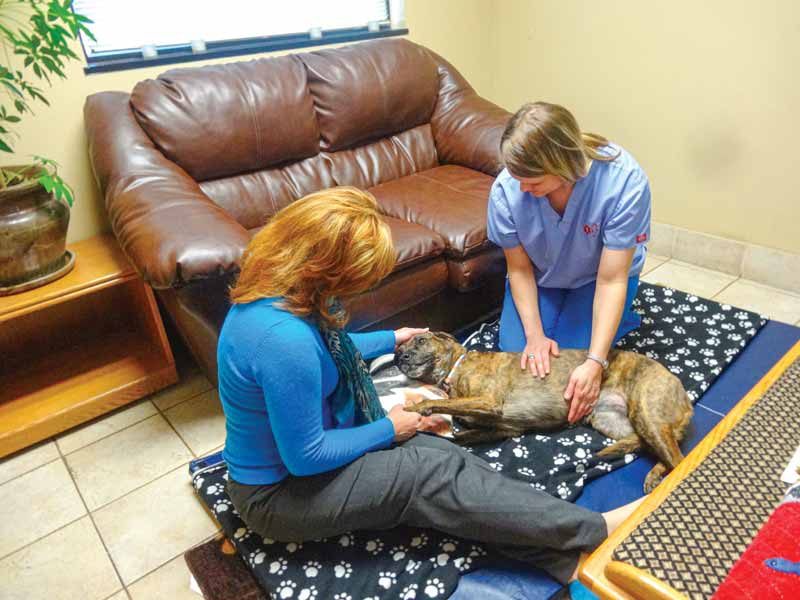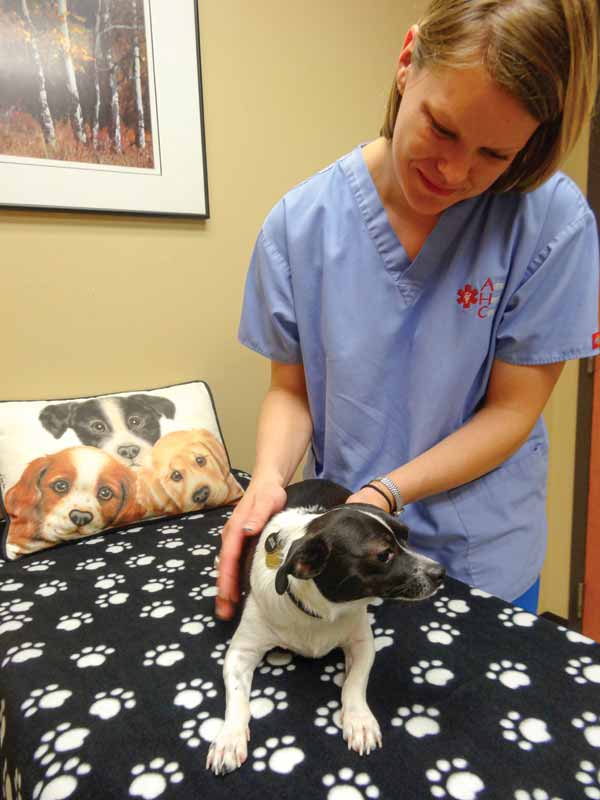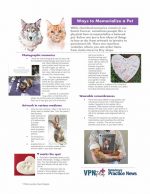
Saying goodbye to pets is an emotional and difficult decision for pet owners. Compassionate communication improves client perceptions of end-of-life conversations.1 Half of what veterinary teams care for is on the other end of the leash—people. Here are ways to support and comfort clients at the time of euthanasia appointments:
1) Be aware of scheduled euthanasia appointments. Client service representatives (CSRs) should check the schedule at the beginning of their shifts and throughout the day to identify euthanasia appointments. Be prepared with appropriate greetings and ensure the paperwork and the exam room are ready in advance.
2) Stand to greet clients and patients by name. Your body language communicates you are solely focused on the client and pet and are ready to assist them. Say, “Hello, [client name] and [pet name]. We’ve been expecting you. Let’s go into the exam room. I will let the doctor and technician know you’ve arrived.”
3) Never make clients wait in the lobby. Emotions will start intensifying upon arrival, and you want to ensure respect and privacy. If exam rooms are full, ask if the client prefers to wait in the car until an exam room becomes available. When the room is ready, the CSR could call the client and meet the pet owner at the front door.
4) Prepare a comfortable exam room. Store nonmedical supplies in a portable cart or in exam room cabinets such as:
- Large, fluffy bath rug with a rubber sole to place on the exam table or floor
- A tri-fold thick exercise mat for large dogs allows clients to sit on the cushioned mat with their pet. A vinyl mat is water-resistant and easy to clean. Install hooks to hang the mat on the wall behind the exam room door when not in use. Besides euthanasia, you can use the mat for hospital visitations and other in-room procedures.
- Blankets, towels, or fleece throws reserved for euthanasia
- Soft instrumental music, nature sounds, or tabletop fountain
- Unscented battery-operated candles
- Basket filled with client comforts such as tissues, bottled water (dehydration is a side effect of crying), small mirror (women may want to check their makeup after crying), small cloth bag for the pet’s collar or hair clippings, and materials to make paw prints
- Dim lights if possible. Turn off overhead fluorescent lights and place a lamp in the room.
- Puppy pads to put under blankets or towels to absorb urine
- Pheromone diffusers
- Food treats
- Pet loss brochures and books

If the procedure will be performed on an exam table, soften the clinical look of steel or
laminate tabletops with a pet-themed fleece blanket, plush towel, or bathmat. Place
a small pillow at the end of the exam table where it connects to the wall to create the
image of a bed.
5) Explain next steps after escorting the client to an exam room. If the pet owner wishes to be present for the euthanasia, the CSR will explain, “I will let the doctor and technician know you are in this exam room. We will discuss final arrangements with you. The doctor will examine your pet, discuss what to expect during the procedure, and answer your questions.”
6) Alert employees so they have respectful voices. Noise from the lobby, treatment area, and hallways could be overheard in exam rooms. Use a “Quiet Please” door hanger, turn off a light in a staff hallway near the exam room, or place an angel magnet on a metal door frame.
7) Show empathy and kindness when presenting consents. Your body language can provide nonverbal support. This might include a gentle smile or a gesture of sympathy, such as passing tissues. During times of intense grief, research shows touch can provide comfort.2 Stick to safe zones of shoulders and arms, such as softly patting the client’s shoulder. If pet owners have closed body language or you are uncomfortable with touching, do not do it. Any interaction must be genuine.
When presenting the consent form, avoid physical barriers between you and the client, such as the exam table. Collaborative body language is to stand at the corner of the exam table, having L-shaped body language between you and the client. When presenting written information to clients, read shoulder-to-shoulder instead of trying to present paperwork upside down and backward from your perspective.
Invite the pet owner to stand next to you so you may review the consent together. Verbally walk clients through consents and then let them read and sign. Use names to connect with pet owners. Avoid the word “body” because to the family it is not the pet’s body, it is still the pet. If you speak with a matter-of-fact tone, clients may perceive you as uncaring and insensitive.
Say, “[Client name], please stand next to me so I may review the consent for final arrangements. This form lets our medical team know your wishes. Let me walk you through four items:
First is the consent for euthanasia. This gives our medical team permission to humanely euthanize your pet. The doctor will explain the procedure and answer your questions before beginning.
Second, our medical team needs to know your pet’s bite history within the past 10 days to identify possible rabies exposure. You will confirm your pet has not bitten any person or animal within the past 10 days, or you will let us know if a bite occurred so the doctor may discuss rabies testing and department of health requirements.
Third, is your choice of what to do with afterward. The first option is to have your pet privately cremated, with ashes returned to you. Our crematory partner is , or you may choose your own crematory. The second option is to have your pet communally cremated together with other pets with a final resting place in a tranquil area on ’s cemetery grounds. If you chose cremation services, your pet would remain at our hospital after the procedure for the crematory to pick up for aftercare services. The third option is to bury your pet at home, and you may want to check your county ordinances before deciding. Please choose which option is best for you and ‘s final resting place.
Fourth, is whether you wish a doctor to perform an autopsy on your pet, which is called a necropsy for animals. Reasons for necropsies may include when it’s not clear why a pet suddenly died, had an undiagnosed disease, is suspected of having rabies, or a legal reason such as a drug reaction.3 If you request a necropsy, a veterinarian will talk with you more. There is an additional fee for necropsy. What questions may I answer? (pause)
I will let you read this consent and make your decisions. Once you have chosen your pet’s final arrangements, I will let the doctor and technician know that you are ready to proceed.”
8) Make it easy for clients to alert your team from the exam room. Clients want privacy to complete consents and say their goodbyes before and after the procedure. Install a wireless doorbell with a chime in the treatment area that the client can ring when he or she is ready to have medical staff return to the exam room. Another option is a “Please come in” door hanger that the client may place on the knob facing the staff hallway.
9) Collect payment before the procedure. A good time to request payment is after the client signs the consent and before the pet is euthanized. After the procedure, clients’ emotions will escalate, and the grieving process will begin. Clients will just want to go home. CSRs or technicians can present the invoice and collect payment in the exam room. Use mobile credit card readers, integrated payments through your practice-management software, and a client communication app that takes payments.
Say, “Thank you, [client name], for letting us know your wishes for [pet name]. I prepared your invoice so you may pay now. For your convenience, we will take payment in the exam room. Here is the invoice, which includes a pre-euthanasia exam, euthanasia services, and aftercare/cremation services. Your total is $__. We accept cash, checks, and credit cards. Which payment method do you prefer?”
After accepting payment, ask, “Do you prefer a printed or emailed receipt?” If the client requests a printed invoice, medical staff can bring it to the exam room when they arrive to discuss the procedure. Minimize the number of times staff will enter and exit the exam room due to the sensitive reason for visit.
Tell the client: “Because you have pre-paid, you may leave whenever you are ready afterward. There is no need to stop at the front desk.” Close with empathetic statements such as:
- “You have our sympathies. [Pet name] is a special companion.”
- “[Pet name] knows he/she is very loved. You are in our thoughts.”
10) Endings matter. Veterinary teams should feel proud when performing a technically strong euthanasia procedure while simultaneously caring for clients’ emotional needs.4 Having standard operating procedures and consistent scripts will create comforting client experiences.
Memorializing a pet
|
Wendy Myers, CVJ, knows the right words will lead clients to accept your medical advice, driving patient and practice health. As founder of Communication Solutions for Veterinarians, she teaches practical skills through online courses, conferences, and onsite consulting. Myers’ experience as a partner in a specialty and emergency hospital helped her understand issues that owners and managers face. Learn how Myers can train your team at csvetscourses.com.
References
- Boatright K. 5 Tools for Addressing Euthanasia Awareness in Pet Owners. PetVet Magazine. https://www.petvetmagazine.com/5-tools-for-addressing-euthanasia-averseness-in-pet-owners/. August 15, 2024.
- Chillot R. The Power of Touch. Psychology Today. https://www.psychologytoday.com/us/articles/the-power-of-touch. August 15, 2024.
- Khuly P. How to Know If Your Pet Needs a Necropsy (And What’s a Necropsy Anyway?). PetMD. Available at: https://www.petmd.com/blogs/dailyvet/2010/february/pet_necropsy-5413. July 30, 2024.
- Cooney K. How to Approach a Meaningful Euthanasia Appointment. Royal Canin. Available at: https://vetfocus.royalcanin.com/en/practice-management/how-i-approach-a-meaningful-euthanasia-appointment. July 30, 2024.

